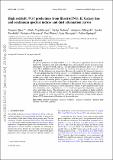| dc.contributor.author | Shen, Xuejian | |
| dc.contributor.author | Vogelsberger, Mark | |
| dc.contributor.author | Nelson, Dylan | |
| dc.contributor.author | Pillepich, Annalisa | |
| dc.contributor.author | Tacchella, Sandro | |
| dc.contributor.author | Marinacci, Federico | |
| dc.contributor.author | Torrey, Paul A. | |
| dc.contributor.author | Hernquist, Lars | |
| dc.contributor.author | Springel, Volker | |
| dc.date.accessioned | 2022-07-22T14:47:53Z | |
| dc.date.available | 2021-09-20T18:23:05Z | |
| dc.date.available | 2022-07-22T14:47:53Z | |
| dc.date.issued | 2020 | |
| dc.identifier.uri | https://hdl.handle.net/1721.1/132567.2 | |
| dc.description.abstract | <jats:title>ABSTRACT</jats:title>
<jats:p>We present predictions for high redshift (z = 2−10) galaxy populations based on the IllustrisTNG simulation suite and a full Monte Carlo dust radiative transfer post-processing. Specifically, we discuss the H α and H β + $[\rm O \,{\small III}]$ luminosity functions up to z = 8. The predicted H β + $[\rm O \,{\small III}]$ luminosity functions are consistent with present observations at z ≲ 3 with ${\lesssim} 0.1\, {\rm dex}$ differences in luminosities. However, the predicted H α luminosity function is ${\sim }0.3\, {\rm dex}$ dimmer than the observed one at z ≃ 2. Furthermore, we explore continuum spectral indices, the Balmer break at 4000 Å; (D4000) and the UV continuum slope β. The median D4000 versus specific star formation rate relation predicted at z = 2 is in agreement with the local calibration despite a different distribution pattern of galaxies in this plane. In addition, we reproduce the observed AUV versus β relation and explore its dependence on galaxy stellar mass, providing an explanation for the observed complexity of this relation. We also find a deficiency in heavily attenuated, UV red galaxies in the simulations. Finally, we provide predictions for the dust attenuation curves of galaxies at z = 2−6 and investigate their dependence on galaxy colours and stellar masses. The attenuation curves are steeper in galaxies at higher redshifts, with bluer colours, or with lower stellar masses. We attribute these predicted trends to dust geometry. Overall, our results are consistent with present observations of high-redshift galaxies. Future James Webb Space Telecope observations will further test these predictions.</jats:p> | en_US |
| dc.language.iso | en | |
| dc.publisher | Oxford University Press (OUP) | en_US |
| dc.relation.isversionof | 10.1093/MNRAS/STAA1423 | en_US |
| dc.rights | Creative Commons Attribution-Noncommercial-Share Alike | en_US |
| dc.rights.uri | http://creativecommons.org/licenses/by-nc-sa/4.0/ | en_US |
| dc.source | arXiv | en_US |
| dc.title | High-redshift JWST predictions from IllustrisTNG: II. Galaxy line and continuum spectral indices and dust attenuation curves | en_US |
| dc.type | Article | en_US |
| dc.contributor.department | Massachusetts Institute of Technology. Department of Physics | en_US |
| dc.contributor.department | MIT Kavli Institute for Astrophysics and Space Research | en_US |
| dc.relation.journal | Monthly Notices of the Royal Astronomical Society | en_US |
| dc.eprint.version | Author's final manuscript | en_US |
| dc.type.uri | http://purl.org/eprint/type/JournalArticle | en_US |
| eprint.status | http://purl.org/eprint/status/PeerReviewed | en_US |
| dc.date.updated | 2020-11-17T15:37:56Z | |
| dspace.orderedauthors | Shen, X; Vogelsberger, M; Nelson, D; Pillepich, A; Tacchella, S; Marinacci, F; Torrey, P; Hernquist, L; Springel, V | en_US |
| dspace.date.submission | 2020-11-17T15:38:07Z | |
| mit.journal.volume | 495 | en_US |
| mit.journal.issue | 4 | en_US |
| mit.license | OPEN_ACCESS_POLICY | |
| mit.metadata.status | Publication Information Needed | en_US |
